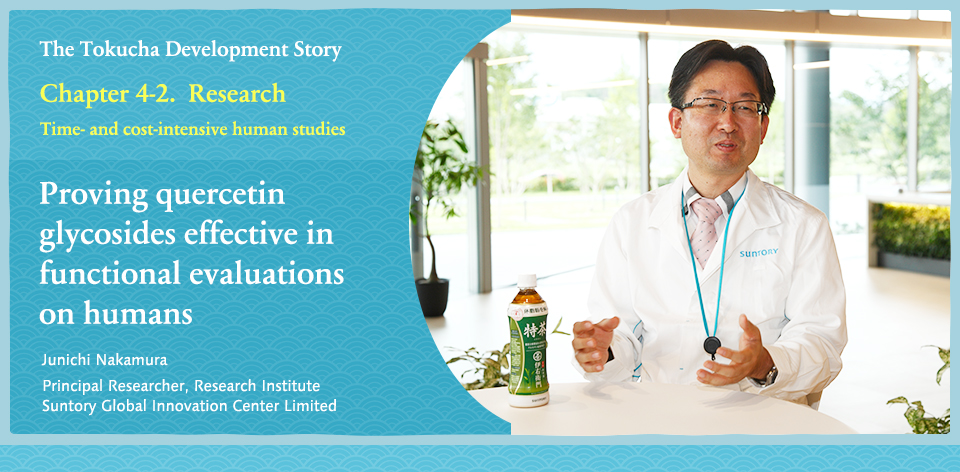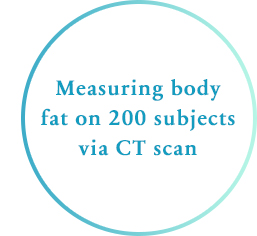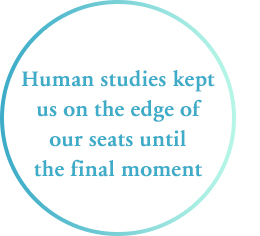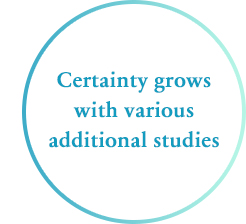- Suntory Global Innovation Center
- > Research & Technology
- > The Tokucha Development Story
- > Chapter 4-2. Time- and cost-intensive human studies
Research & Technology

Once we had finished narrowing down our list of potential ingredients, we began tests to confirm that drinking these ingredients was effective in reducing body fat. We had our subjects undergo energy metabolism tests in which they drank beverages containing the different ingredients, pedaled bicycles, and exhaled so we could collect the gases and measure the amount of fat being burned.
What we found was that quercetin glycosides demonstrated the greatest fat-burning effect, so we selected it as our final ingredient and kept going with more tests.
Our ultimate aim was to create a beverage that would make people slimmer by reducing body fat. We knew that people were burning fat when they pedaled the bicycles, but we couldn’t yet say whether that alone would make them slimmer. We needed to prove that people were able to lose body fat when they consistently drank beverages containing quercetin glycosides.
The standard test used to evaluate whether body fat was decreasing is using CT scan to take a section of the abdominal area and measure the total fat area. We gave 100 participants a beverage containing quercetin glycosides, and another 100 a beverage without them. The participants drank what we gave them every day for twelve weeks, and did not know which beverage they were drinking.
Most of the people used in the study were adults with a BMI of between 25〜30kg/2 which is the level that defines the target population for fat-reducing FOSHU products.


People with medical conditions requiring treatment are not within the scope of FOSHU products, so they had to be excluded. Some of the people willing to be in our study had blood pressure or blood sugar levels high enough to require medical attention—so we asked them to prioritize treatment above their participation in our study. Essentially, the study targeted people who were prone to carrying excess weight but who were otherwise healthy.
We conducted a double-blind, parallel-group comparison study in which we had a third party divide the subjects into two groups, ensuring that neither the participants nor the researchers had any idea who was drinking what beverage until the very end. This supported objective evaluations and ensured high reliability for our tests.
Once the twelve weeks of the study were finished, we finally broke the seal on the envelope containing the unblinding6 documents identifying which participants were in which beverage group. We had come to the end of the experiment, and had no idea whether we had gotten the results we wanted until that very moment. We were jittery with anticipation.
It had taken three months just for the participants to drink the beverages, and if we included the preparatory stages that preceded the experiment, it had taken us a full nine months to arrive at the findings. If we didn’t get the results we hoped for, those nine months of hard work would all be for nothing. On the day the unblinding documents were opened, I found myself heading towards the Minase Shrine located near where our lab was at the time. It may sound funny, but at that point there was nothing left to do but pray!
6 In a double-blind study, the unblinding documents are revealed after the study is completely finished and all data have been finalized, indicating which participants were in which beverage group.
When we finally analyzed the test data, we found that the group drinking the beverage containing quercetin glycosides clearly showed reduced fat area over the group drinking the other beverage. We had clearly proven our hypothesis that ongoing consumption of quercetin glycosides reduced body fat.
We also ran dose-finding trials, pharmacokinetics experiments7, excessive intake examinations, and a variety of other studies. In fact, we ran not just one but multiple human studies in which we verified whether or not quercetin glycosides reduced body fat. We weren’t planning to offer a green tea–type beverage at first, but when we ran a human study using a green tea drink like Tokucha, we were able to demonstrate the same fat-reducing effects.
In that sense as well, I felt that we had stumbled upon a truly wonderful ingredient. As we collected more findings confirming my original hunch, I gradually became more and more convinced myself that quercetin glycosides was going to do exactly what we wanted it to.


* The department name, title, and photo are as of the time of the production (interview).
* The department name, title, and photo are as of the time of the production (interview).










